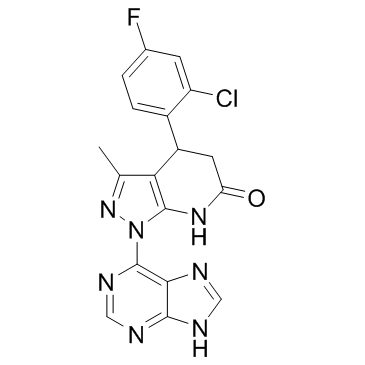| Description |
TM-N1324 is an agonist of G-Protein-Coupled Receptor 39 (GPR39) with EC50s of 9 nM/5 nM in the presence of Zn2+, and 280 nM/180 nM in the absence of Zn2+ for human/murine GPR39.
|
| Related Catalog |
|
| Target |
EC50: 280 nM (human GPR39 without Zn2+), 9 nM (human GPR39 with Zn2+), 180 nM (murine GPR39 without Zn2+), 5 nM (murine GPR39 with Zn2+)[1]
|
| In Vitro |
TM-N1324 activates human GPR39 with high efficacy and potencies of 280 nM and 9 nM in the absence and presence of Zn2+, respectively. TM-N1324 has similar potencies on murine GPR39, 180 nM and 5 nM. TM-N1324 is also found to have promising in vitro ADME properties. TM-N1324 has reasonably good aqueous solubility (65 μM at pH 7.0). Measurements of somatostatin confirms that the GPR39 agonist TM-N1324 increases somatostatin release by 53%[1].
|
| Cell Assay |
Caco-2 cells are used as an in vitro model of the human intestinal epithelium and permit assessment of the intestinal permeability of TM-N1324. TM-N1324 is added to either the apical or basolateral side of a confluent monolayer of Caco-2 cells and permeability is measured by monitoring the appearance of the TM-N1324 on the opposite side of the membrane using LC-MS/MS. TM-N1324 (3 µM) is incubated with pooled liver microsomes and incubated at 5 time points over the course of a 45 min experiment finally TM-N1324 is analyzed by LC-MS/MS. The intrinsic clearance (CLint) and t1/2 values for TM-N1324 in human and mouse microsomes are reported[1].
|
| References |
[1]. Frimurer TM, et al. Model-Based Discovery of Synthetic Agonists for the Zn2+-Sensing G-Protein-Coupled Receptor 39 (GPR39) Reveals Novel Biological Functions. J Med Chem. 2017 Feb 9;60(3):886-898.
|
